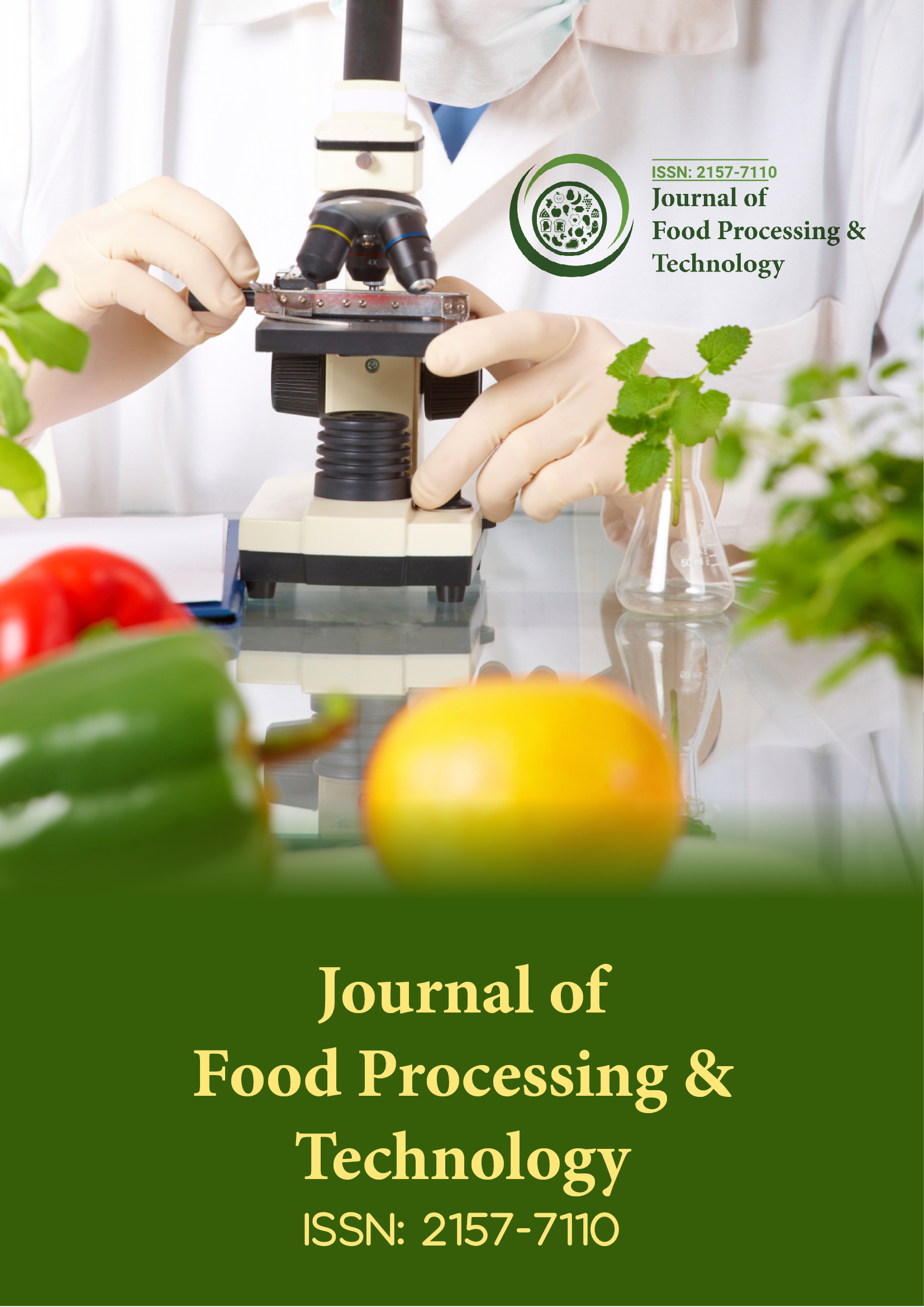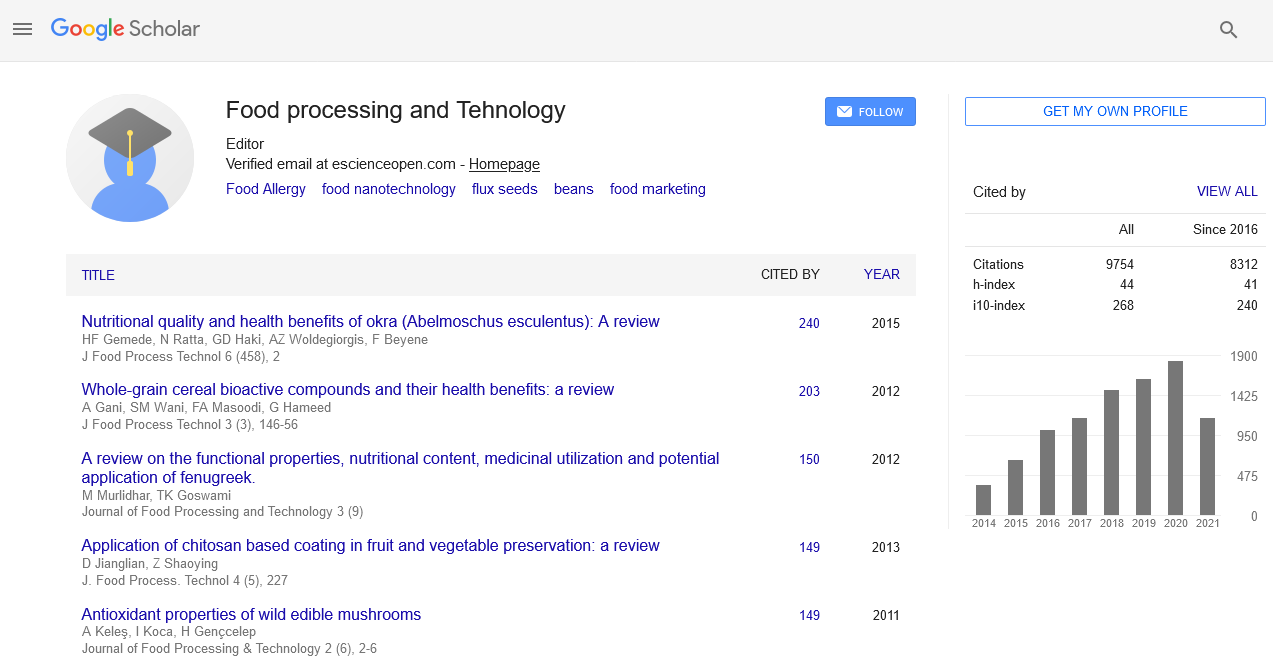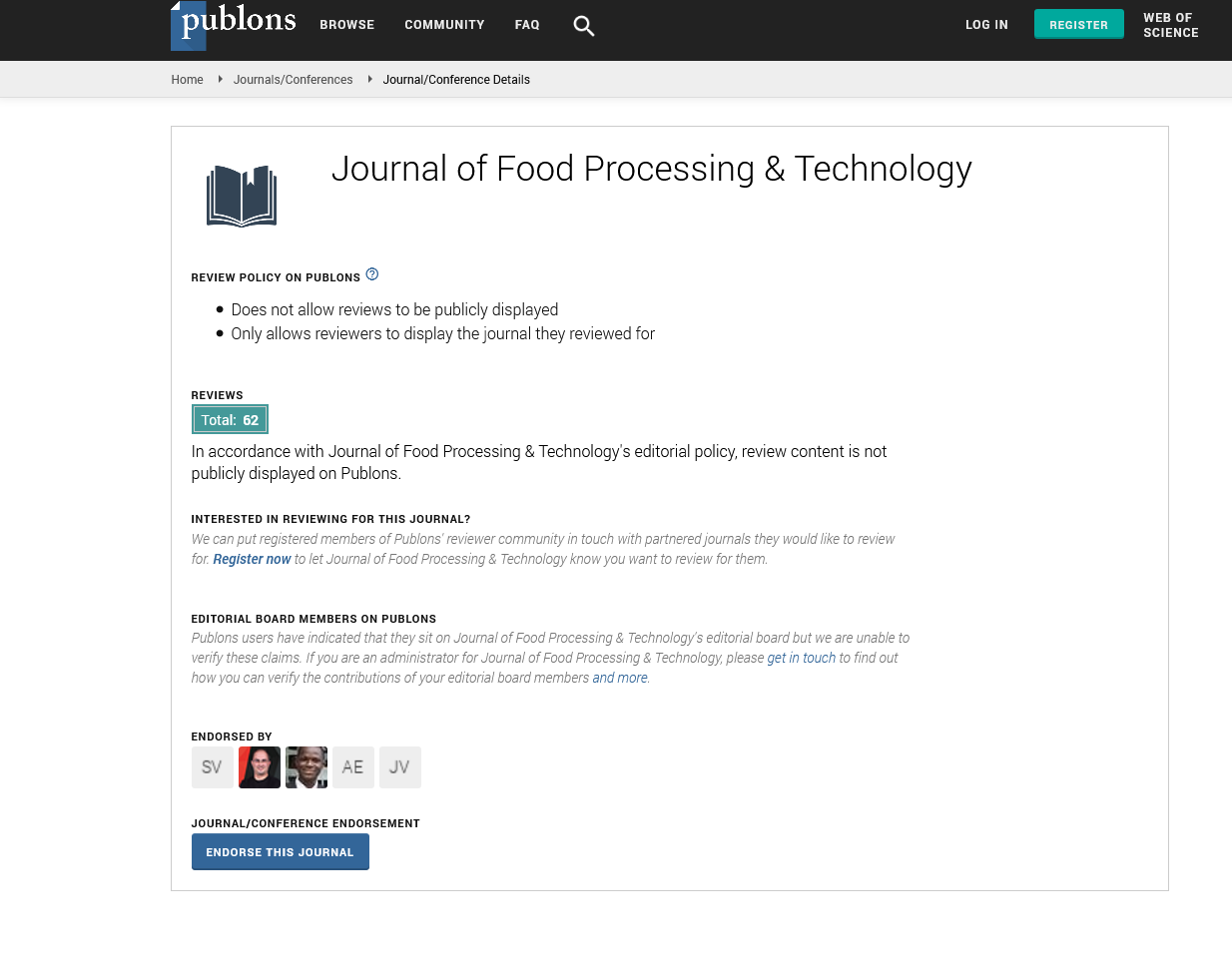Indexed In
- Genamics JournalSeek
- Academic Keys
- JournalTOCs
- China National Knowledge Infrastructure (CNKI)
- Access to Global Online Research in Agriculture (AGORA)
- Centre for Agriculture and Biosciences International (CABI)
- RefSeek
- Directory of Research Journal Indexing (DRJI)
- Hamdard University
- EBSCO A-Z
- OCLC- WorldCat
- Scholarsteer
- SWB online catalog
- Publons
- Euro Pub
- Google Scholar
Useful Links
Share This Page
Journal Flyer

Open Access Journals
- Agri and Aquaculture
- Biochemistry
- Bioinformatics & Systems Biology
- Business & Management
- Chemistry
- Clinical Sciences
- Engineering
- Food & Nutrition
- General Science
- Genetics & Molecular Biology
- Immunology & Microbiology
- Medical Sciences
- Neuroscience & Psychology
- Nursing & Health Care
- Pharmaceutical Sciences
Short Communication - (2025) Volume 16, Issue 1
Advances in Cold Plasma Technology for Food Preservation
Hannah Collins*Received: 27-Jan-2025, Manuscript No. JFPT-25-29160; Editor assigned: 29-Jan-2025, Pre QC No. JFPT-25-29160; Reviewed: 12-Feb-2025, QC No. JFPT-25-29160; Revised: 18-Feb-2025, Manuscript No. JFPT-25-29160; Published: 26-Feb-2025, DOI: 10.35248/2157-7110.25.16.1147
Description
Cold plasma technology has emerged as a promising nonthermal food preservation method that ensures microbial safety while preserving the nutritional and sensory properties of food. As consumer demand rises for minimally processed, fresh-like and additive-free foods, the food industry is increasingly turning to innovative solutions like cold plasma to meet safety and quality standards without compromising product integrity. Cold plasma, often referred to as the fourth state of matter, is an ionized gas comprising a complex mixture of ions, electrons, neutral atoms, Reactive Oxygen Species (ROS), Reactive Nitrogen Species (RNS) and ultraviolet photons [1]. It is generated under atmospheric or low-pressure conditions using energy sources such as microwave, radiofrequency, or Dielectric Barrier Discharge (DBD). The reactive species produced in cold plasma possess strong antimicrobial properties, which make them effective against a wide spectrum of foodborne pathogens and spoilage organisms, including bacteria, yeasts, molds and viruses.
One of the major advantages of cold plasma technology lies in its non-thermal nature, making it ideal for preserving heat-sensitive food products such as fresh fruits, vegetables, dairy, seafood and meat. Unlike traditional heat treatments, cold plasma does not significantly affect the color, flavor, texture, or nutritional profile of food products. This makes it a highly attractive technique for clean-label food processing, where minimal use of synthetic preservatives is desired [2]. Recent studies have demonstrated the effectiveness of cold plasma in reducing microbial load on the surface of various foods. For example, plasma treatment has shown substantial reductions in E. coli, Listeria monocytogenes and Salmonella on fresh produce, poultry and ready-to-eat products. The efficacy of cold plasma depends on several factors including treatment duration, gas composition (e.g., air, oxygen, argon), power input and the type of food matrix. Optimization of these parameters is crucial to achieve microbial inactivation without adversely impacting product quality [3].
In addition to microbial decontamination, cold plasma has also been explored for other food-related applications such as pesticide degradation on fruits and vegetables, toxin neutralization, seed decontamination and enhancement of seed germination. Furthermore, the technology has potential in packaging—cold plasma can modify the surface of packaging materials to improve their barrier properties or to sterilize packaging before filling [4]. Despite these promising applications, there are challenges and limitations associated with the commercial adoption of cold plasma. One major challenge is the lack of standardized protocols and regulatory frameworks for its implementation in food industries. Food processors need clear guidelines regarding acceptable treatment levels, safety assessments and labeling requirements. Another concern is the scale-up of cold plasma systems from laboratory settings to industrial operations, which requires significant technological and infrastructural adaptation. There is also ongoing research into the long-term effects of cold plasma treatment on food quality, shelf life and nutritional content [5]. While short-term studies are encouraging, more comprehensive evaluations are necessary to understand the impact of reactive species over extended storage periods. Additionally, consumer perception of plasma-treated foods must be considered, especially regarding food safety, naturalness and product labeling.
Future advancements in cold plasma technology will likely focus on hybrid systems that combine cold plasma with other preservation methods (e.g., refrigeration, vacuum packaging, or UV-C treatment) to enhance microbial safety and extend shelf life even further. The integration of cold plasma with smart sensors and real-time monitoring tools may also help in creating adaptive processing systems tailored to specific food categories [6]. Moreover, cold plasma technology is expected to evolve with the integration of Artificial Intelligence (AI) and Machine Learning (ML) for real-time process optimization. These tools can analyze treatment parameters, predict microbial inactivation rates and adapt the plasma exposure dynamically based on the specific characteristics of the food being treated. This approach would not only increase the efficiency of the preservation process but also minimize the risk of overexposure or under-treatment [7].
Another promising avenue is the development of portable and cost-effective cold plasma devices for small-scale or on-site applications. This would be particularly beneficial for small and medium-sized food enterprises, local farms and retail outlets. Mobile plasma systems could be used for on-the-spot decontamination of fresh produce at local markets, enhancing food safety right at the point of sale [8]. In terms of research and innovation, interdisciplinary collaboration among food technologists, microbiologists, physicists and engineers will be essential to further explore and refine the applications of cold plasma. Collaborative efforts will help establish standardized testing protocols, improve scalability and address concerns related to regulatory approvals and consumer acceptance. On the consumer front, educational initiatives and transparent labeling will play a crucial role in improving public perception. Since cold plasma-treated foods are often misunderstood as being exposed to “radiation” or “chemical agents,” clear communication about the process, its safety and its benefits is vital. Informative labeling and outreach through awareness campaigns can help alleviate skepticism and promote informed choices among consumers [9, 10].
References
- Subramani T, Ganapathyswamy H. An overview of liposomal nano-encapsulation techniques and its applications in food and nutraceutical. J Food Sci Technol. 2020 ;57(10):3545-55.
[Crossref] [Google Scholar] [PubMed]
- Braga MC, Vieira EC, de Oliveira TF. Curcuma longa L. leaves: Characterization (bioactive and antinutritional compounds) for use in human food in Brazil. Food Chem. 2018;265:3
[Crossref] [Google Scholar] [PubMed]
- Keil C, Grebenteuch S, Kröncke N, Kulow F, Pfeif S, Kanzler C, et al. Systematic studies on the antioxidant capacity and volatile compound profile of yellow mealworm larvae (T. molitor L.) under different drying regimes. Insect. 2022;13(2):166.
[Crossref] [Google Scholar] [PubMed]
- Moreno J, Echeverria J, Silva A, Escudero A, Petzold G, Mella K, et al. Apple snack enriched with L-arginine using vacuum impregnation/ohmic heating technology. Food Sci Technol Int. 2017;23(5):448-56.
[Crossref] [Google Scholar] [PubMed]
- RóżyÅ?o R, Piekut J, Dziki D, Smolewska M, GawÅ?owski S, Wójtowicz A, et al. Effects of wet and dry micronization on the GC-MS identification of the phenolic compounds and antioxidant properties of freeze-dried spinach leaves and stems. Mol. 2022;27(23):8174.
[Crossref] [Google Scholar] [PubMed]
- Sirohi R, Tarafdar A, Gaur VK, Singh S, Sindhu R, Rajasekharan R, et al. Technologies for disinfection of food grains: Advances and way forward. Food Res Int. 2021;145:110396.
[Crossref] [Google Scholar] [PubMed]
- Nowak D, Jakubczyk E. The freeze-drying of foods: The characteristic of the process course and the effect of its parameters on the physical properties of food materials. Foods. 2020;9(10):1488.
[Crossref] [Google Scholar] [PubMed]
- Bhatta S, Stevanovic Janezic T, Ratti C. Freeze-drying of plant-based foods. Foods. 2020;9(1):87.
[Crossref] [Google Scholar] [PubMed]
- Pandiselvam R, Aydar AY, Kutlu N, Aslam R, Sahni P, Mitharwal S, et al. Individual and interactive effect of ultrasound pre-treatment on drying kinetics and biochemical qualities of food: A critical review. Ultrason Sonochem. 2023;92:106261.
[Crossref] [Google Scholar] [PubMed]
- da Cunha RM, Brandão SC, de Medeiros RA, da Silva Júnior EV, da Silva JH, Azoubel PM. Effect of ethanol pretreatment on melon convective drying. Food Chem. 2020;333:127502.
[Crossref] [Google Scholar] [PubMed]
Citation: Collins H (2025). Advances in Cold Plasma Technology for Food Preservation. J Food Process Technol.16: 1147.
Copyright: © 2025 Collins H. This is an open access article distributed under the terms of the Creative Commons Attribution License, which permits unrestricted use, distribution and reproduction in any medium, provided the original author and source are credited.


